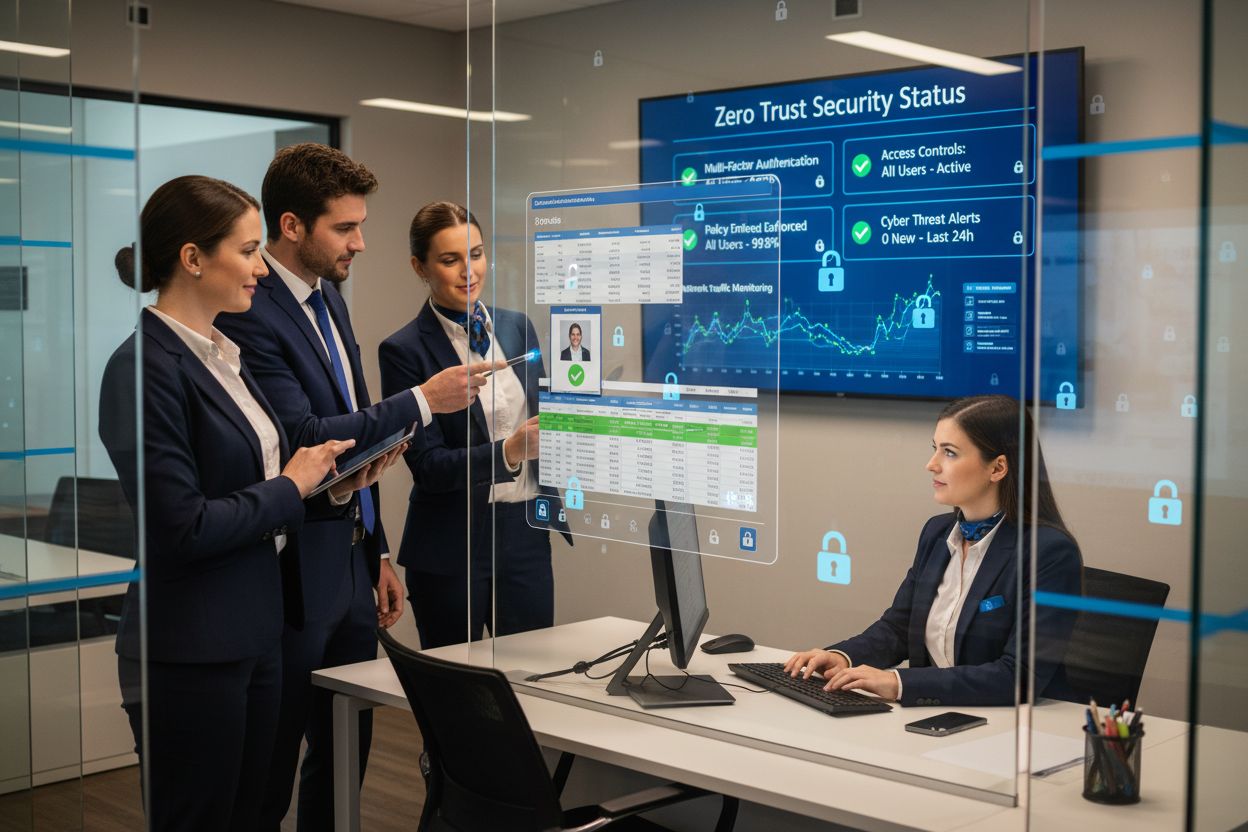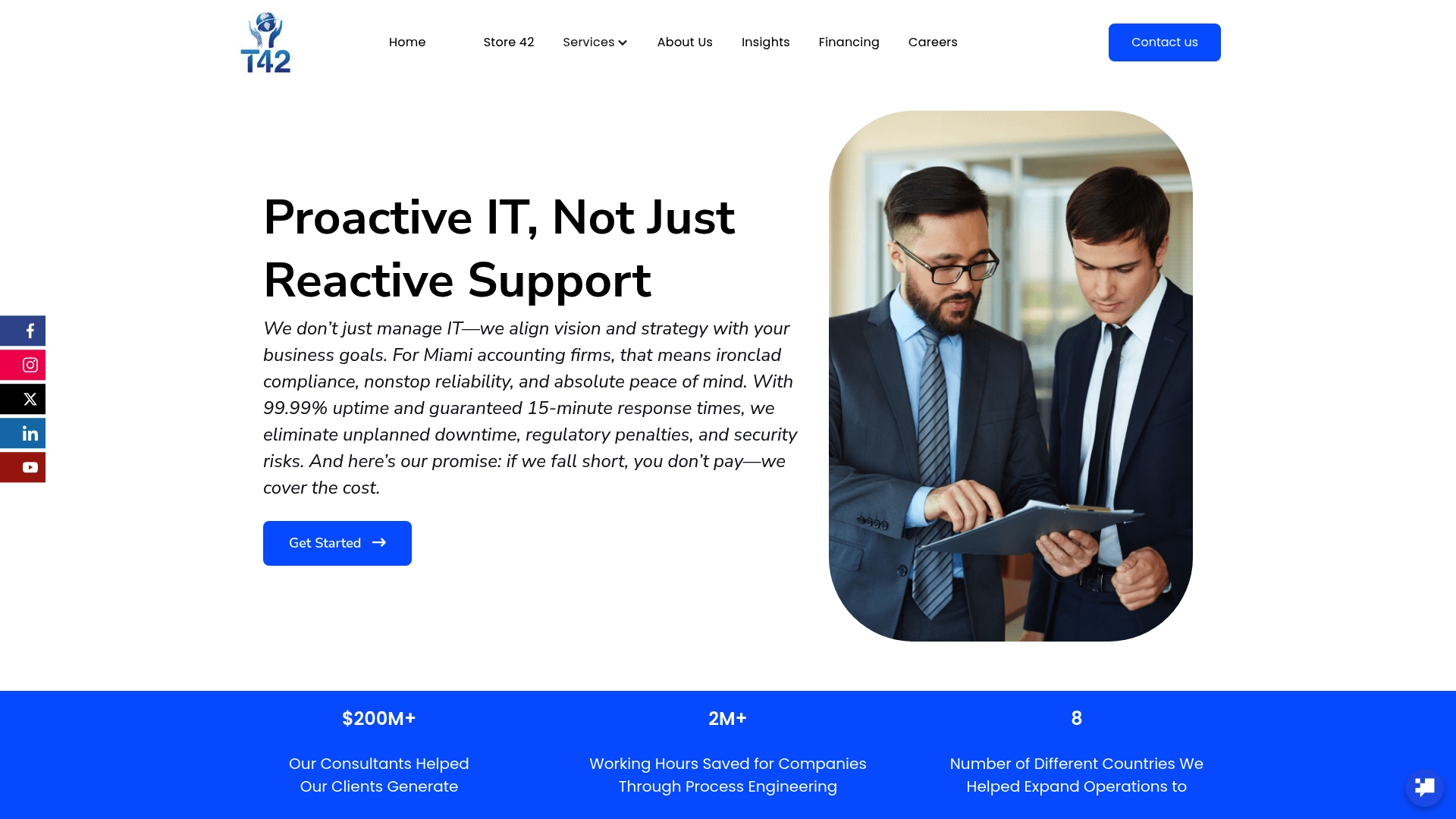
Did you know that nearly 60 percent of accounting firms have faced cyber threats in the past year? Protecting financial data goes far beyond passwords and firewalls. The stakes are high, and even a single breach can leave lasting damage. Zero Trust Security flips the old rules upside down by questioning every user, device, and connection. This guide shows how a modern security mindset can keep accounting firms ahead of evolving cyber risks.
| Point | Details |
|---|---|
| Zero Trust Philosophy | Treats every digital interaction as a potential threat, requiring continuous verification of users, devices, and networks. |
| Key Security Layers | Essential components include identity verification, network segmentation, and dynamic access control to enhance protection against breaches. |
| Implementation Roadmap | Transitioning to Zero Trust requires a phased approach involving assessment, segmentation, and continuous monitoring of IT infrastructure. |
| Risks and Challenges | Common pitfalls include legacy system incompatibility, productivity bottlenecks, and the administrative burden of constant identity verification. |
In the high-stakes world of accounting, where financial data is your most precious asset, Zero Trust Security isn’t just a fancy tech term—it’s your digital bodyguard. Imagine a security approach that treats every single digital interaction like a potential threat, regardless of where it comes from. That’s Zero Trust in a nutshell.
According to the Cloud Security Alliance, Zero Trust Architecture (ZTA) operates on some core principles that completely flip traditional network security on its head. Instead of assuming everything inside your network is safe, Zero Trust demands continuous verification for every single connection. Think of it like having a bouncer check ID at every single door, not just the main entrance.
Here’s what Zero Trust means for your accounting practice:
By adopting Zero Trust, you’re not just protecting spreadsheets and client records. You’re creating an ironclad digital fortress that adapts in real-time, keeps cybercriminals guessing, and ensures your firm’s most sensitive financial information remains locked down tight.

When it comes to protecting your accounting firm’s digital ecosystem, Zero Trust Security isn’t just a theoretical concept—it’s a hands-on, moment-by-moment approach to keeping your data safe. Think of it like having a hyper-vigilant security team that checks credentials for every single interaction, no matter who’s asking or where they’re coming from.
Research from cutting-edge blockchain studies reveals fascinating implementation strategies. According to blockchain security research, Zero Trust frameworks can leverage advanced technologies like smart contracts to enforce multi-factor authentication and role-based access control. For an accounting practice, this means creating a dynamic security environment where access isn’t just granted—it’s continuously re-evaluated.
Here’s how Zero Trust actually works in your daily operations:
As emerging research from Zero-Trust Foundation Models suggests, this approach goes beyond traditional security. It’s about creating a living, breathing security ecosystem that adapts, learns, and protects your most sensitive client financial information with unprecedented precision. Your firm doesn’t just have security—it becomes security.
In the complex world of accounting, Zero Trust Security isn’t just about building walls—it’s about creating a sophisticated, adaptive security ecosystem that protects your most sensitive financial data. Think of it like a smart, constantly evolving security system that doesn’t just block threats but intelligently responds to them.
According to cutting-edge research on zero trust security in cloud environments, the core components of this approach go far beyond traditional network security. The framework involves critical layers like micro-segmentation, which breaks your network into smaller, more manageable segments, and least privileged access, ensuring team members only see exactly what they need to see.
Here are the essential security layers every accounting firm needs:
![]()
Here’s a comparison of core Zero Trust security layers and how they protect accounting firms:
| Security Layer | Primary Purpose | Key Benefit for Accounting Firms |
|---|---|---|
| Identity Verification | Confirm user identity | Prevents unauthorized account access |
| Network Segmentation | Isolate network zones | Limits breach impact to specific areas |
| Continuous Monitoring | Track all user/system activities | Detects and responds to threats instantly |
| Dynamic Access Control | Adjust permissions by context | Ensures just-in-time access |
| Encrypted Communication | Protect data in transit | Safeguards financial data transmissions |
Research from the TrustZero framework introduces an innovative concept of a ‘trust token’—a cryptographically secure method of establishing identity that’s adaptable across different systems. For accounting firms, this means creating a robust, mathematically grounded approach to verifying who’s accessing your most critical financial information. Read our article on beyond perimeter security to dive deeper into these cutting-edge strategies.
Transitioning to Zero Trust Security isn’t just flipping a switch—it’s a strategic journey that requires careful planning, patience, and a deep understanding of your accounting firm’s unique digital ecosystem. Think of it like renovating an old house: you can’t change everything overnight, but you can make meaningful improvements that dramatically boost your security.
According to research on zero trust deployment challenges, implementing this security model in financial infrastructures involves navigating complex integration landscapes. For accounting firms, this means thoughtfully addressing potential roadblocks like legacy system compatibility, remote work scenarios, and maintaining smooth operational workflows while introducing stricter security protocols.
Here’s a practical roadmap for implementing Zero Trust:
As research from TechTarget highlights, implementing Zero Trust isn’t without challenges. Potential productivity impacts and ongoing administration requirements mean you’ll need a strategic, phased approach. Check out our guide to managed IT services for additional insights into making this transition smooth and effective for your accounting practice.
Implementing Zero Trust Security isn’t a walk in the park—it’s more like navigating a complex maze where one wrong turn can expose your entire accounting practice to potential vulnerabilities. Your firm’s digital security is only as strong as its weakest link, and understanding potential pitfalls is crucial to building a robust defense system.
According to research on Zero Trust deployment, accounting firms face significant challenges when transitioning to this security model. The primary hurdles include adapting legacy systems, managing continuous administrative overhead, and potentially disrupting existing workflow productivity. These aren’t just technical challenges—they’re strategic decisions that can impact your entire operational ecosystem.
Here are the most critical risks to watch out for:
Research from Aykira’s comprehensive analysis reveals that unencrypted data and inconsistent security protocols remain significant vulnerabilities. For a deeper understanding of navigating these complex financial management challenges, check out our guide on financial management service risks.
The challenge you face is clear: protecting sensitive financial data while navigating legacy systems, complex user management, and continuous monitoring demands. Zero Trust Security principles like multi-factor authentication and dynamic access control offer a strategic path forward but implementing these without disrupting productivity can be daunting. Your goal is ironclad compliance paired with nonstop reliability to eliminate downtime and security risks.
At Transform42, we specialize in aligning IT strategy with your firm’s vision, delivering tailored Zero Trust solutions backed by a 99.99% uptime guarantee and rapid 15-minute response times. You gain a security partner who understands the specific risks you face — from legacy system integration hiccups to managing constantly evolving access controls — so you can focus fully on your clients without fear of breaches or penalties.
Take the first step toward a resilient, adaptive security posture that protects your practice 24/7.

Discover how our comprehensive IT services safeguard your accounting firm’s most critical information. Visit Transform42 homepage to explore our approach and start your Zero Trust journey today. Learn more and secure your firm’s future with confidence by connecting with us now.
The key principles of Zero Trust Security include no automatic trust for any user or device, constant authentication and authorization, access granted only to specific resources needed for a task, session-specific permissions that change based on context, and a least privilege access model.
Zero Trust Security improves data protection by requiring continuous verification for every user and device, thereby minimizing the risk of unauthorized access and potential breaches, creating a robust digital fortress for sensitive financial information.
Essential components of a Zero Trust Security framework include identity verification (using multi-factor authentication), network segmentation, continuous monitoring of user activities, dynamic access control that adjusts permissions based on context, and encrypted communication to protect data in transit.
Accounting firms may face challenges such as legacy system incompatibility, productivity bottlenecks due to strict access controls, complex user management due to constant identity verification, inconsistent data classification protocols, and issues with key management related to encryption practices.